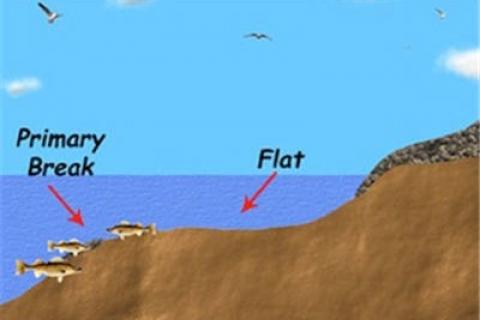
 As summer begins to wind down and the season edges toward autumn, walleye location and activity level makes a transition. Fish begin to move off the flats and begin to congregate near sharper breaks. They’re not exactly “bunched up,” but they aren’t widely scattered over a piece of structure either. While the water temps have dropped significantly from where they were several weeks ago, the feeding activity of the walleyes really hasn’t. They may not be “jumpin’ in the boat,” but they’re still in a feeding mood, looking to build up their reserves for the upcoming cold water season.
As summer begins to wind down and the season edges toward autumn, walleye location and activity level makes a transition. Fish begin to move off the flats and begin to congregate near sharper breaks. They’re not exactly “bunched up,” but they aren’t widely scattered over a piece of structure either. While the water temps have dropped significantly from where they were several weeks ago, the feeding activity of the walleyes really hasn’t. They may not be “jumpin’ in the boat,” but they’re still in a feeding mood, looking to build up their reserves for the upcoming cold water season.
Vertical jigging, a reliable technique to be sure, will catch fish, but it’s a slow process to cover structure this way. With these conditions in mind, it begins to make sense that a finesse presentation designed to cover more water would be just the ticket to catching these fish. That’s what jig trolling is … it’s a “mobile-finesse” angle on an old reliable presentation.
Cover small areas with finesse. Normally when you think of trolling, it conjures up visions of moving along at speeds between 1.5 and 2.5 mph, with lures trailing out behind the boat 100 feet or more. This is not the case when it comes to jig trolling. Remember, the object is to cover relatively small areas efficiently and with finesse. Moving along structure with the Bow Mount electric motor at ½ to ¾ mph is more the speed you’re looking for. Letting out too much line will also defeat the purpose of using a jig. Jigging, even jig trolling, requires a good feel of what the lure is doing at all times. It’s best to keep the jig at about a 45-degree angle to the rod tip to get the maximum sensitivity in the presentation. A simple “lift-pause-drop” action to the jig as you move along will keep the bait in the strike zone while maintaining good feel of the bottom.
The gear used for jig trolling is very similar to that used in other jigging techniques. A high-modulus graphite, 6-foot, medium to medium light action spinning rod like Bass Pro Shops’ Walleye Angler Signature Series model WA60ML-HM85 works just great for this application. For jig trolling in deeper water (30 feet and deeper), a longer rod, like the 7-foot model WA70MS-HM85, can have an advantage when it comes to getting a good hook set with considerably more line out.
Line choice is also similar to other jigging methods, with top choices being no-stretch 6-2 Berkley FireLine or low-stretch 6-pound test Berkley Sensation. The less stretch the line has, the more it will telegraph through the rod just what’s happening with the jig. It’s important to maintain bottom contact, and using equipment that will enhance sensitivity will put you well ahead of the game.
 Jig size will typically range from 1/4 ounce to 1/2 ounce, depending on depth and wind conditions. The key is to choose a jig that allows you to cover the water yet maintain good feel.
Jig size will typically range from 1/4 ounce to 1/2 ounce, depending on depth and wind conditions. The key is to choose a jig that allows you to cover the water yet maintain good feel.
Tipping the jig with a live minnow is common, but more and more, artificial dressings are proving just as effective in many instances. Some of the more popular artificials would include the Berkley Gulp 3-inch Minnow, Berkley PowerBait Realistix 4-inch Power Minnow, as well as a Berkley Gulp 3-inch Fry. In clear water, stick with natural colors, but if you're dealing with stained or dingy water, don't be afraid to experiment with brighter colors like chartreuse. These artificial tails have plenty of scent and action to attract walleyes and are much easier to keep than live bait.
by Keith Kavajecz
- 4960 views

